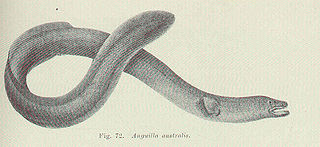
The short-finned eel, also known as the shortfin eel, is one of the 15 species of eel in the family Anguillidae. It is native to the lakes, dams and coastal rivers of south-eastern Australia, New Zealand, and much of the South Pacific, including New Caledonia, Norfolk Island, Lord Howe Island, Tahiti, and Fiji.
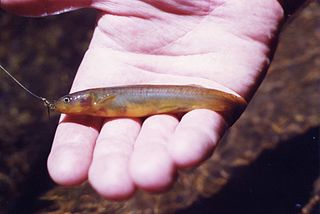
The Galaxiidae are a family of mostly small freshwater fish in the Southern Hemisphere. The majority live in Southern Australia or New Zealand, but some are found in South Africa, southern South America, Lord Howe Island, New Caledonia, and the Falkland Islands. One galaxiid species, the common galaxias, is probably the most widely naturally distributed freshwater fish in the Southern Hemisphere. They are coolwater species, found in temperate latitudes, with only one species known from subtropical habitats. Many specialise in living in cold, high-altitude upland rivers, streams, and lakes.

The climbing galaxias or kōaro is a fish of the family Galaxiidae found in Australia, New Zealand, and nearby islands. The name climbing galaxias is used in Australia, and koaro or kōaro in New Zealand. Further vernacular names include short-finned galaxias, broad-finned galaxias, Cox's mountain galaxias, and Pieman galaxias.

The common galaxias or inanga is a very widespread Southern Hemisphere fish in the family Galaxiidae. It is a slim, narrow fish with a forked tail and a mottled, spotty pattern, typically about 10 cm (4 in) long when fully grown. It lives in fresh water, but spawns at river mouths and spends the first six months of its life at sea, returning en masse in spring. Its vernacular names include cowfish, jollytail, common jollytail, eel gudgeon, inaka, native trout, pulangi, puye, slippery tarki, spotted minnow, Falklands minnow and whitebait.

The New Zealand smelt, also known as the New Zealand common smelt, New Zealand cucumber fish, or silveries is a smelt of the family Retropinnidae, found only in New Zealand at shallow depths in estuaries and rivers. Their length is between 8 and 13 cm.

The New Zealand longfin eel is a species of freshwater eel that is endemic to New Zealand. It is the largest freshwater eel in New Zealand and the only endemic species – the other eels found in New Zealand are the native shortfin eel, also found in Australia, and the naturally introduced Australian longfin eel. Longfin eels are long-lived, migrating to the Pacific Ocean near Tonga to breed at the end of their lives. They are good climbers as juveniles and so are found in streams and lakes a long way inland. An important traditional food source for Māori, longfin eel numbers are declining and they are classified as endangered, but over one hundred tonnes are still commercially fished each year.

The giant kōkopu is a threatened species of ray-finned fish in the genus Galaxias, found only in New Zealand. It can reach up to 58 cm (23 in) in length and 2.7 kg (6.0 lb) in weight, making it the largest species in the family Galaxiidae. It is a mainly lowland species, commonly found in slow-flowing streams, wetlands, lakes, and lagoons. Most populations have an amphidromous life cycle, with larvae going to sea soon after hatching and returning about four months later as small juveniles, 4.5–5 cm (1.8–2.0 in). Juvenile giant kōkopu form a small part of the annual whitebait catch.

The common river galaxias or Canterbury galaxias is a galaxiid fish of the genus Galaxias, found only in the Canterbury and Otago regions of New Zealand.

The torrentfish, or panoko (Māori), is an amphidromous freshwater ray-finned fish that is endemic to New Zealand. Torrentfish are well adapted to life in shallow, fast-flowing riffles and rapids. They grow to a maximum of 20 cm (7.9 in) in total length, but more commonly reach 10–12 cm (3.9–4.7 in).
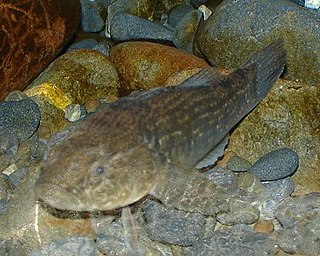
The giant bully, tītarakura, or tīpokopoko (Māori), is a species of fish in the family Eleotridae endemic to New Zealand.
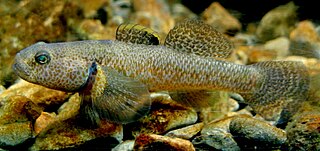
The upland bully is a species of fish in the family Eleotridae endemic to freshwater habitats in New Zealand. Both sexes have distinctive orange-brown dots all over the head. Adults generally reach a length of 8–10 cm (3.1–3.9 in).
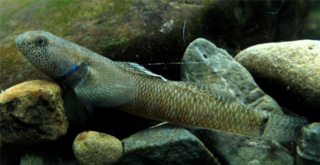
The bluegill bully is a fish in the family Eleotridae that is endemic to New Zealand. It lives in shallow, fast-flowing riffles and torrents, where it forages and shelters amongst the gravels. It has a similar distribution to the other endemic riffle specialist, the torrentfish. It can be found up to 100 kilometres (62 mi) inland, and from sea level up to an elevation of 480 metres (1,570 ft). The bluegill bully is the smallest of the Eleotrids, commonly reaching only 60–70 mm (2.4–2.8 in).

The redfin bully is a species of freshwater fish in the family Eleotridae endemic to New Zealand. Being amphidromous, it spends part of its life cycle at sea. Males have distinctive bright red patterns and stripes on their fins. Adults grow to an average of 80–100 mm (3.1–3.9 in) total length, with a maximum of 120 mm (4.7 in).

Paranephrops is a genus of freshwater crayfish found only in New Zealand. They are known by the English common names freshwater crayfish and koura, the latter from their Māori name of kōura.
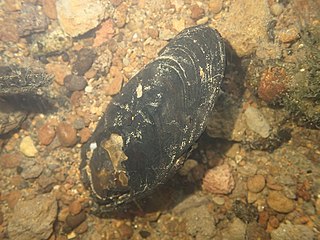
Echyridella menziesii, the New Zealand freshwater mussel, also known by its Māori names kākahi, kāeo, and torewai, is a species of freshwater mussel endemic to New Zealand. E. menziesii is an aquatic bivalve mollusc in the family Unionidae, the river mussels.

The bluefin gurnard or Pacific red gurnard is a species of marine ray-finned fishes belonging to the family Triglidae, the gurnards and sea robins. Its Māori names are kumukumu and pūwahaiau. It is found in the western Indian Ocean and the western Pacific Ocean, being common around Australia and New Zealand at depths down to 200 metres (660 ft). The fish is one of the most important commercial fish species in New Zealand.

Aquaculture started to take off in New Zealand in the 1980s. It is dominated by mussels, oysters and salmon. In 2007, aquaculture generated about NZ$360 million in sales on an area of 7,700 hectares. $240 million was earned in exports.

Mangrove ecosystems represent natural capital capable of producing a wide range of goods and services for coastal environments and communities and society as a whole. Some of these outputs, such as timber, are freely exchanged in formal markets. Value is determined in these markets through exchange and quantified in terms of price. Mangroves are important for aquatic life and home for many species of fish.

Gobiomorphus is a genus of fishes in the family Eleotridae native to New Zealand and Australia. They are typically small, benthic fishes with large, rounded fins and two dorsal fins. Many have an amphidromous lifecycle: the eggs are laid in fresh water, but the fry are dispersed to sea soon after hatching, and grow there for several months before returning to fresh water.
Lake Harihari is a dune-dammed lake 10 km south of Kawhia in the Waikato region of New Zealand. Its water quality is the best amongst the Waikato dune lakes. It is ranked eighth in importance in the region. Its quality has been attributed to its remoteness.





















